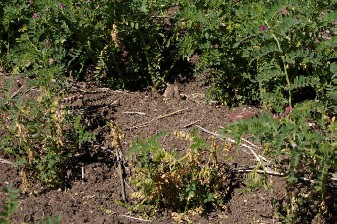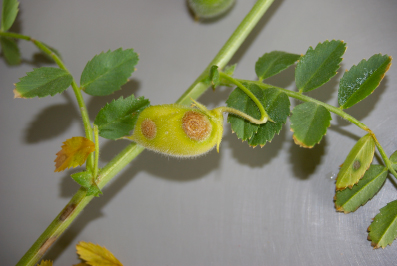Typical ascochyta blight leaf lesions with pale centres, dark edges and black pycnidia (that look like black dots) in the centre of the lesions. In more advanced lesions, concentric rings of black pycnidia may appear on the leaves and stems.
Concern over ascochyta in southern chickpea
There are several confirmed reports of ascochyta blight (AB) in commercial crops of previously resistant chickpea varieties in the Victorian Mallee.
Consequently, Pulse Australia is encouraging growers and advisors in Victoria and South Australia to monitor all chickpea crops and prepare to apply preventative sprays to protect crops.
Paddock symptoms
- First symptoms are typical ascochyta blight leaf lesions with pale centres, dark edges and black pycnidia (which look like black dots) in the centre of the lesions. In more advanced lesions, concentric rings of black pycnidia may appear on the leaves and stems.
- Generally this disease becomes obvious in late winter when small patches of blighted plants (blackened side branches, dead leaves, potentially broken stems) appear throughout the paddock.

Identification of ascochyta blight (AB) on chickpea plants
- The fungus attacks all above-ground plant parts including leaves, stems and pods at any stage of plant growth.
- Initially, ascochyta blight appears on the younger leaves as small, water-soaked pale spots.
- These spots rapidly enlarge under cool and wet conditions, joining with other spots on the leaves and blighting the leaves and buds.
- On these lesions, small black spots (pycnidia) can be seen in the affected areas. In severe cases the entire plant dries up suddenly.
- Elongated lesions form on the stem and may girdle the stem.
- The stem may die and break off. Regrowth may occur from this point.
- Affected areas on the pods tend to be round, sunken, with pale centres and dark margins. The fungus can penetrate the pod and infect the seed.

Severity of ascochyta blight (AB) in crop
- The disease spreads during cool, wet weather in winter and spring from isolated plants to surrounding plants by rainsplash of spores. Large blighted patches develop within crops.
- Plants are most susceptible in rainy, humid conditions.
- Pods on all varieties are susceptible to infection irrespective of foliar resistance. Infection of pods will lead to pod abortion and seed staining.
- Ascochyta blight causes low yields with poor seed quality and can result in up to 100% yield loss in the most susceptible varieties. Where does inoculum come from? Ascochyta blight is caused by the pathogenic fungus Phoma rabiei, previously referred to as Ascochyta rabiei. The pathogen survives on chickpea residue, on seed and on volunteer chickpeas.
Has the ascochyta pathogen changed?
Early data from research conducted by Australian chickpea researchers indicates that the pathogen has changed and is adapting to resistant varieties. Genetic resistance to AB in chickpeas is highly complex, which makes it difficult to monitor changes in pathogen virulence.
Ongoing research is being conducted to understand these complex interactions. At this stage, the Australian chickpea researchers have detected a growing number of isolates that are highly aggressive on Genesis 090 and PBA HatTrick in controlled environment trials. Several highly aggressive isolates appear to be broadly adapted to the growing region and cultivar and are being monitored for. The most highly aggressive and commonly detected isolates are being used for resistance selection in the national chickpea breeding program.
Treatment
Currently the available products for use in chickpea include Unite and Barrack (chlorothalonil), Captan, Amistar Xtra (azoxystrobin plus cyproconazole) and Prosaro (prothioconazole plus tebuconazole).
Fungicides should be rotated between groups with no more than two applications of the same group applied during a single growing season (except for chlorothalonil, which can be applied up to 3 times with no restrictions in terms of application order).
There is a high risk that the pathogen may develop resistance to fungicides if the same fungicides are used repeatedly.
Mancozeb (various) or metiram (Polyram®) can also control ascochyta if timeliness of application is observed.
On susceptible cultivars fortnightly mancozeb sprays are required compared to chlorothalonil sprays every 21 days. (Refer to Pulse Australia bulletin: Chickpea disease management: Southern region.
Apply fungicide sprays ahead of rain fronts to prevent fungal infection and spread.
Fungicide availability and permits
The availability of mancozeb appears to be improving. The label rate for a 750 g/kg mancozeb product for chickpea is 1.0 – 2.2 kg/ha. Please refer to local experience when deciding upon use rates but a typical rule of thumb is:
- for prophylactic sprays for ascochyta blight use 1.0 kg/ha
- once ascochyta blight has been confirmed within a crop, increase the rate to 2.0 kg/ha
- The following permits have been issued for the control of ascochyta blight in chickpea crops:
- Captan (800 & 900 g/kg Captan products) APVMA Permit PER81406 http://permits.apvma.gov.au/PER81406.PDF
- Amistar Xtra Fungicide (200 g/L azoxystrobin & 80 g/L cyproconazole) APVMA Permit PER81470 http://permits.apvma.gov.au/PER81470.PDF
- Prosaro 420 SC Foliar Fungicide (210 g/L prothioconazole & 210 g/L tebuconazole) APVMA Permit PER81474 http://permits.apvma.gov.au/PER81474.PDF
Optimise the number and sequence of foliar fungicide sprays
The number of fungicide sprays during the season depends on chickpea variety and disease severity. If disease is prolific, multiple applications may be required.
Southern Pulse pathologists are encouraging growers and agronomists to apply fungicide to all chickpea crops, even resistant varieties such as Genesis 509 and Genesis 090, for protection against AB at podding since pods of all varieties are susceptible to ascochyta infection.
Fungicide sprays are no longer necessary when the crop reaches the late-pod stage, regardless of disease severity at that time. If applied after late-pod stage, fungicide may delay plant maturation.
Plant pathology laboratories
In South Australia please send your chickpea samples to:
Courier: SARDI, Plant and Soil Health Plant Research Centre Gate 2B, Hartley Grove Urrbrae SA 5064
Postal: SARDI, Plant and Soil Health Locked Bag 100 Glen Osmond SA 5064
In Victoria, please send your chickpea samples to:
CropSafe DPI Victoria 110 Natimuk Road Horsham. VIC 3400 Phone: 03 53 622 111
For further information
http://www.pulseaus.com.au/growing-pulses/bmp/chickpea http://pulseaus.com.au/storage/app/media/crops/2012_SPB-Chickpea-disease-management.pdf http://www.croppro.com.au/crop_disease_manual/ch05s01.php#Ch1439Se266064
Acknowledgements
Dr Jenny Davidson, Snr Plant Pathologist, SARDI Helen Richardson, Plant Pathologist, DEDJTR VIC Associate Professor, Rebecca Ford, Griffith University Southern Pulse Agronomy Program

